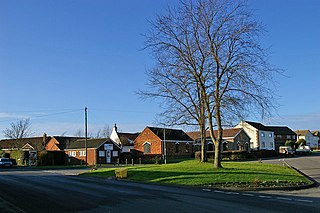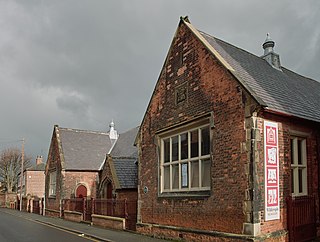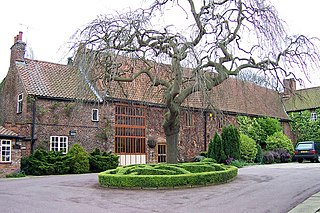
The Humber is a large tidal estuary on the east coast of Northern England. It is formed at Trent Falls, Faxfleet, by the confluence of the tidal rivers Ouse and Trent. From there to the North Sea, it forms part of the boundary between the East Riding of Yorkshire on the north bank and North Lincolnshire on the south bank. Although the Humber is an estuary from the point at which it is formed, many maps show it as the River Humber.

Brigg (/'brɪg/) is a market town in North Lincolnshire, England, with a population of 5,076 in the, the population increased to 5,626 at the 2011 census. The town lies at the junction of the River Ancholme and east–west transport routes across northern Lincolnshire. As a formerly important local centre, the town's full name of Glanford Brigg is reflected in the surrounding area and local government district of the same name. The town's urban area includes the neighbouring hamlet of Scawby Brook.

Whitton is a village and civil parish in North Lincolnshire, England. The 2011 census found 212 inhabitants, in 92 households. It is situated at the northern termination of the Lincoln Cliff range of hills, on the south shore of the Humber about 3 miles (4.8 km) below Trent Falls, and 9 miles (14 km) west of Barton-upon-Humber. The parish is bounded on the west by Alkborough, on the east by Winteringham and, to the south, by West Halton.

Barton-upon-Humber or Barton is a town and civil parish in North Lincolnshire, England. The population at the 2011 census was 11,066. It is situated on the south bank of the Humber Estuary at the southern end of the Humber Bridge. It is 46 miles (74 km) east of Leeds, 6 miles (10 km) south-west of Kingston upon Hull and 31 miles (50 km) north north-east of the county town of Lincoln. Other nearby towns include Scunthorpe to the south-west and Grimsby to the south-east.

Winterton is a small town or large village with amenities in North Lincolnshire, England, 5 miles (8 km) north-east of Scunthorpe. The 2011 census found 4,899 inhabitants, in 2,001 households. Major north-south/east-west streets of Winterton are Market Street and Northlands Road. Winterton is near to the banks of the Humber and is 8 miles (13 km) south-west of the Humber Bridge which can be seen from many parts of the town.

South Killingholme is a village and civil parish in North Lincolnshire, England. The population of the civil parish at the 2011 census was 1,108.

Grimsby Town railway station serves the town of Grimsby in North East Lincolnshire, England. It is operated by TransPennine Express, and is also served by East Midlands Railway and Northern Trains services.

The Barton line is a railway line in North and North East Lincolnshire, England. It runs from Barton-upon-Humber south east to Cleethorpes and was designated by the Department for Transport as a community rail line in February 2007. Barton station is near to the Humber Bridge. It is situated on the south bank of the Humber Estuary.

Barton-on-Humber railway station serves the town of Barton-upon-Humber in North Lincolnshire, England.

St Peter's Church is the former parish church of Barton-upon-Humber in North Lincolnshire, England. It is one of the best known Anglo-Saxon buildings, in part due to its role in Thomas Rickman's identification of the style. It has been subject to major excavations. The former Church of England church is now run by English Heritage and houses an exhibition exploring its history.

Richard Rhodes is a Seattle, Washington-based sculptor, stonemason, entrepreneur, and scholar of stonework worldwide.

Anglo-Saxon turriform churches were an Anglo-Saxon style of church that were built in the form of towers. They can also be called tower-nave churches.

Saxby All Saints is a village and civil parish in North Lincolnshire, England. The population of the civil parish at the 2011 census was 385. It is 6 miles (9.7 km) north of Brigg and 4 miles (6.4 km) south-west of Barton upon Humber.
The Barton and Immingham Light Railway is a railway line in North Lincolnshire and North East Lincolnshire, Lincolnshire, England. It ran from a junction at Goxhill to Immingham Dock. Another spur runs from Immingham Dock to Ulceby. It was later absorbed by the Great Central Railway and later, on grouping, it passed to the London and North Eastern Railway. The railway is used for freight traffic to the ports at Immingham. The section from Goxhill to North Killingholme was mothballed and lifted. The track is still in situ but now overgrown and out of use.
The south bank of the Humber Estuary in England is a relatively unpopulated area containing large scale industrial development built from the 1950s onward, including national scale petroleum and chemical plants as well as gigawatt scale gas fired power stations.

Far Ings national nature reserve is an area of over 90 ha on the southern shore of the Humber Estuary in North Lincolnshire, England. It is immediately west of the town of Barton-upon-Humber and the village of Barton Waterside. In addition to being designated as a national nature reserve, it is within the Humber Estuary Ramsar site, Site of Special Scientific Interest, Special Area of Conservation, and Special Protection Area.

William Dalison of Laughton in the parish of Lindsey, Lincolnshire, was Sheriff of Lincolnshire in 1546 and Escheator of Lincolnshire.

The Wilderspin National School is a former national school and Grade II listed building in Barton-upon-Humber, North Lincolnshire, and a museum focussing on the life and works of Samuel Wilderspin.

Tyrwhitt Hall is a late medieval residence and a Grade II* Listed building in Barton-upon-Humber, North Lincolnshire.
















